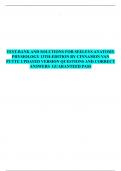lOMoARcPSD|25922779 TEST -BANK AND SOLUTIONS FOR SEELEYS ANATOMY PHYSIOLOGY 13TH -EDITION BY CINNAMON V AN PUTTE UPDATED VERSION QUESTIONS AND CORRECT ANSWERS GUARANTEED PASS Seeley's Anatomy and Physiology, 13e (VanPutte) Chapter 2 The Chemical Basis of Life 1) The amount of matter in an object is its ________. A) mass B) weight C) atomic number D) element E) ionic charge Answer: A Section: 02.01 Bloom's: 1. Remember Learning Outcome: 02.01A. Define matter, mass, and weight. Topic/Accessibility: Atoms and molecules / HAPS Topic/HAPS Objective: Module C Chemistry and Cell Biology Review / C01.01d Distinguish among the terms atomic number, mass number and atomic wei ght with respect to the structure of an atom. 2) The three forms of matter are A) air, water, and solids. B) solids, liquids, and gases. C) blood, bone, and air. D) vapor, water, and solid. Answer: B Section: 02.01 Bloom's: 1. Remember Learning Outcome: 02.01A. Define matter, mass, and weight. Topic/Accessibility: Atoms and molecules; Chemistry and cell biology / HAPS Topic/HAPS Objective: Module C Chemistry and Cell Biology Review / C01.01a With respect to the structure of an atom: Describe the charge, mass, and relative location of electrons, protons and neutrons. 3) The four most abundant elements in the human body are A) carbon, hydrogen, oxygen, and iron. B) carbon, hydrogen, oxygen, and nitrogen. C) calcium, hydrogen, sodium, and potassium. D) carbon, oxygen, magnesium, and zinc. E) carbon, sulfur, calcium, and potassium. Answer: B Section: 02.01 Bloom's: 1. Remember Learning Outcome: 02.01B. Distinguish between an element and an atom, and state the fo ur most abundant elements in the body. Topic/Accessibility: Atoms and molecules; Chemistry and cell biology / HAPS Topic/HAPS Objective: Module C Chemistry and Cell Biology Review / C01.03 Compare and contrast the terms atoms, molecules, elements, and co mpounds. 4) The smallest particle of an element that still exhibits the chemical characteristics of that element is a/an ________. A) electron B) atom C) chemical bond D) orbital E) proton Answer: B Section: 02.01 Bloom's: 1. Remember Learning Outcome: 02.01B. Distinguish between an element and an atom, and state the four most abundant elements in the body. Topic/Accessibility: Atoms and molecules; Chemistry and cell biology / HAPS Topic/HAPS Objective: Module C Chemistry and Cell Biology Review / C01.03 Compare and contrast the terms atoms, molecules, elements, and compounds. 5) Subatomic particles located around the nucleus of an atom are ________. A) protons B) electrons C) neutrons D) neutrinos E) photons Answer: B Section: 02.01 Bloom's: 1. Remember Learning Outcome: 02.01C. Name the subatomic particles of an atom, and indicate their mass, charge and location in an atom. Topic/Accessibility: Atoms and molecules; Chemistry and cell biology / HAPS Topic/HAPS Objective: Module C Chemistry and Cell Biology Review / C01.01a Describe the charge, mass, and relative location of electrons, protons and neutrons with resp ect to the structure of an atom. 6) Electrons A) comprise the majority of the mass of an atom. B) are located in the nucleus of an atom. C) have a positive charge of one. D) are the subatomic particles most involved in bonding behavior of atoms.





